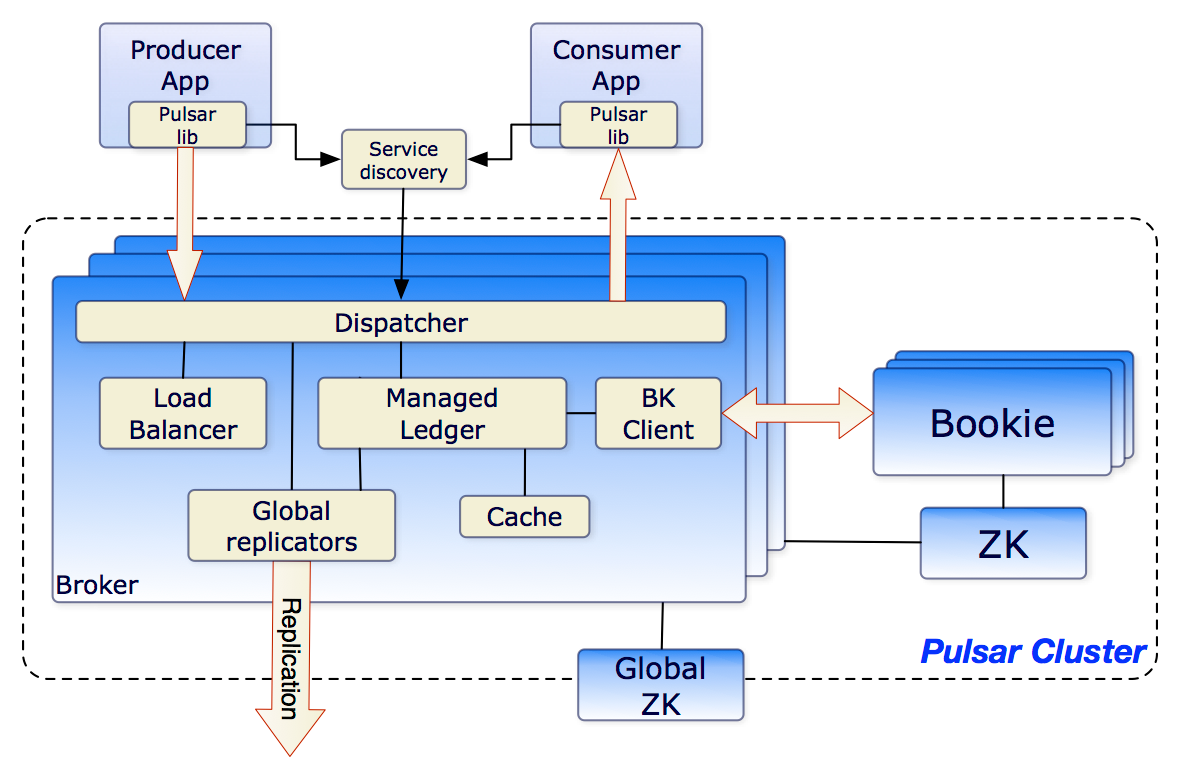

(Jurik Peter/Shutterstock)
Yahoo today announced that it’s open sourcing Pulsar, a new distributed “publish and subscribe” messaging systems designed to be highly scalable while maintaining low levels of latency. The bus already backs some of Yahoo’s key apps, and now the Web giant is seeking the help of the open source community to take Pulsar to the next level.
In a post to the Yahoo Engineering blog, Yahoo developers Joe Francis and Matteo Merli explained the application requirements that spurred the creation of the new “pub-sub” messaging system that would become Pulsar.
“These applications provide real-time services, and need publish-latencies of 5ms on average and no more than 15ms at the 99th percentile,” they write. “At Internet scale, these applications require a messaging system with ordering, strong durability, and delivery guarantees.” The messages must also be committed to multiple disks or nodes in order to get to the 99.999% guaranteed durability level, they add.
“At the time we started, we could not find any existing open-source messaging solution that could provide the scale, performance, and features Yahoo required to provide messaging as a hosted service, supporting a million topics,” Francis and Merli write. “So we set out to build Pulsar as a general messaging solution, that also addresses these specific requirements.”
Yahoo designed Pulsar to scale horizontally on commodity hardware, and to provide messaging as a service to multiple applications. The system can scale to handle millions of independent topics and millions of messages published per second, according to Pulsar’s GitHub page.
Developers and administrators interact with Pulsar through a collection of APIs. The software also includes a client library that encapsulates the messaging protocol and handles “complex” functions like service discovery and establishing and recovering connections.
Pulsar Architecture
A Pulsar cluster is composed of a set of brokers, BookKeepers (or bookies), and ZooKeeper for coordination and configuration management. A Pulsar instance typically consists of multiple physical clusters that are geographically separated from one another, Yahoo says.
Pulsar uses Apache Bookkeeper (committed by Yahoo to open source in 2011) as its durable storage mechanism. “With Bookkeeper, applications can create many independent logs, called ledgers,” Pulsar’s project page on GitHub says. “A ledger is an append-only data structure with a single writer that is assigned to multiple storage nodes (or bookies) and whose entries are replicated to multiple of these nodes.”
Pulsar uses brokers to serve topics. Each topic is assigned to a broker, and an individual broker can serve thousands of topics, Yahoo says. “The broker accepts messages from writers, commits them to a durable store, and dispatches them to readers,” Yahoo says.
An instance of Apache Zookeeper keeps all the other pieces of Pulsar working together. Yahoo contributed ZooKeeper to the Apache Software Foundation in 2008, and since then the software has become a key component of Apache Hadoop and other big data frameworks.
It appears the use of BookKeeper is key to Pulsar’s high level of durability, and the capability to scale elements of the messaging bus independently. It also offers clues as to why Yahoo developed Pulsar in the first place, and didn’t rely on other open source messaging systems, such as Apache Kafka.
“By using separate physical disks (one for journal and another for general storage), bookies are able to isolate the effects of read operations from impacting the latency of ongoing write operations, and vice-versa,” the Yahoo developers write on their blog. “Since read and write paths are decoupled, spikes in reads – which commonly occur when readers drain backlog to catch up – do not impact publish latencies in Pulsar. This sets Pulsar apart from other commonly-used messaging systems.”
While Kafka was available when Yahoo started developing Pulsar, the technology didn’t offer some of the features that Yahoo’s engineering team required, Yahoo tells Datanami.
Specifically, features like offset (cursor) management, geo-replication, multi-tenancy, and performance under message backlog conditions were not available in Kafka then, and some even aren’t available now, a Yahoo spokesperson says.
Yahoo’s engineering team deployed its first Pulsar instance in the spring of 2015, and use of it has grown quickly since then. Today Pulsar backs Yahoo applications like Mail, Finance, Sports, Gemini Ads, and Sherpa, which is Yahoo’s distributed key-value service. All told, Pulsar publishes more than 100 billion messages per day across 1.4 million topics with an average latency of less than 5 ms.
By making Pulsar available under an Apache 2.0 license, Yahoo hopes to spur development of the messaging bus. Specific areas the company is currently looking to improve upon include decreasing the tiem it takes to migrate tpics among brokers from 10 seconds to less than one second, improving the 99.9-percentile publish latencies to 5ms, and providing additional language bindings for Pulsar.
Yahoo’s Pulsar project is not to be confused with the real-time analytics platform named Pulsar that came out eBay. You can read more about the eBay Software Foundation’s product at gopulsar.io.
April 30, 2025
- LogicMonitor Expands AI Observability Platform with Agentic AIOps and New Partnerships
- KNIME Turns Enterprise Data into Action, Demonstrates Custom AI Agents
- Pythian Boosts Global Data and AI Services with Rittman Mead Integration
- Collibra Harris Poll Finds 86% of Data Leaders Cite Privacy as Top Concern Amid AI Adoption
- StarTree Adds AI-Native MCP and Vector Embedding to Power Real-Time RAG and Agentic Apps
- DDN and Nebius Partner to Deliver Scalable AI Infrastructure for Enterprise Applications
- Backblaze Introduces High-Performance B2 Overdrive Cloud Storage for Data-Intensive Workloads
- Acceldata Unveils AI-Driven Anomaly Detection Engine to Automate Data Quality
- BigID Launches AI Data Lineage to Enhance AI Transparency and Governance
- Quobyte Launches Version 4 to Support AI Training and Scale-Out Workloads Across Hybrid Environments
April 29, 2025
- DataOps.live Named Data Breakthrough Awards’ DataOps Company of the Year
- Akamai Firewall for AI Enables Secure AI Applications with Advanced Threat Protection
- Denodo Launches Platform 9.2 with Enhanced Data Marketplace and GenAI Features
- NetApp Adds Quantum-Safe Encryption and AI Ransomware Detection to ONTAP
- Elastic Launches Automatic Migration to Simplify SIEM Migration
- Argonne Examines Opportunities and Risks of GenAI Tools
- GigaIO Demonstrates Power and Cost Savings with New AI Interconnect Benchmarks
- RWS TrainAI Study Finds Claude Sonnet, GPT and Gemini Pro Lead in Synthetic Data Generation
- Open Compute Project Foundation and UALink Consortium Announce a New Collaboration
April 28, 2025
- PayPal Feeds the DL Beast with Huge Vault of Fraud Data
- OpenTelemetry Is Too Complicated, VictoriaMetrics Says
- Thriving in the Second Wave of Big Data Modernization
- Google Cloud Preps for Agentic AI Era with ‘Ironwood’ TPU, New Models and Software
- Google Cloud Fleshes Out its Databases at Next 2025, with an Eye to AI
- Can We Learn to Live with AI Hallucinations?
- Monte Carlo Brings AI Agents Into the Data Observability Fold
- Slash Your Cloud Bill with Deloitte’s Three Stages of FinOps
- AI Today and Tomorrow Series #3: HPC and AI—When Worlds Converge/Collide
- The Active Data Architecture Era Is Here, Dresner Says
- More Features…
- Google Cloud Cranks Up the Analytics at Next 2025
- New Intel CEO Lip-Bu Tan Promises Return to Engineering Innovation in Major Address
- AI One Emerges from Stealth to “End the Data Lake Era”
- GigaOM Report Highlights Top Performers in Unstructured Data Management for 2025
- SnapLogic Connects the Dots Between Agents, APIs, and Work AI
- Supabase’s $200M Raise Signals Big Ambitions
- Snowflake Bolsters Support for Apache Iceberg Tables
- Dataminr Bets Big on Agentic AI for the Future of Real-Time Data Intelligence
- GenAI Investments Accelerating, IDC and Gartner Say
- Dremio Speeds AI and BI Workloads with Spring Lakehouse Release
- More News In Brief…
- Gartner Predicts 40% of Generative AI Solutions Will Be Multimodal By 2027
- Dataiku Achieves AWS Generative AI Competency
- AMD Powers New Google Cloud C4D and H4D VMs with 5th Gen EPYC CPUs
- MLCommons Releases New MLPerf Inference v5.0 Benchmark Results
- Opsera Raises $20M to Expand AI-Driven DevOps Platform
- GitLab Announces the General Availability of GitLab Duo with Amazon Q
- Dataminr Raises $100M to Accelerate Global Push for Real-Time AI Intelligence
- Intel and IBM Announce Availability of Intel Gaudi 3 AI Accelerators on IBM Cloud
- Kinaxis Partners with Databricks to Accelerate AI-Powered Supply Chain Orchestration
- SAS Partners with Kansas State to Advance AI-Driven Water Management
- More This Just In…



























